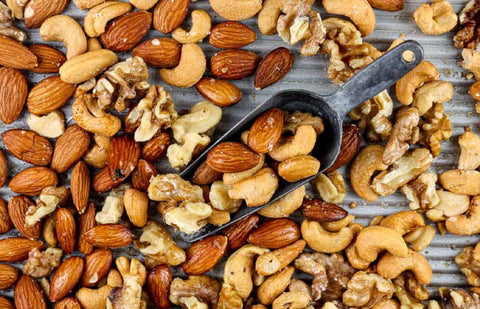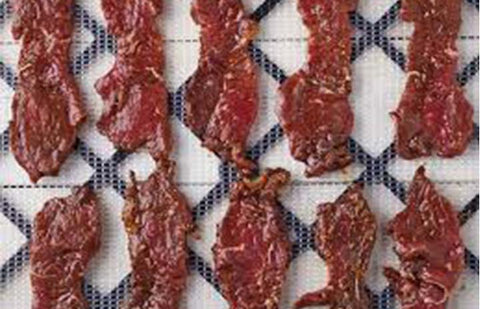Say goodbye to junk food with home-dehydrated treats that you'll adore

Maximizing Nutrition and Minimizing Waste with a Septree Food Dehydrator
One of the best features of a Septree food dehydrator is the ability to create healthy snacks and meals while retaining the nutrients and flavors of whole foods.
This appliance gently dries fruits and vegetables, extending their lifespan and reducing waste. By sourcing high-quality ingredients yourself, you gain control over what goes into your dishes. Let's examine how this dehydrator supports creating nourishing pantry staples.
Contemporary cooking methods such as canning often deplete vitamins, minerals, and enzymes due to high heat and moisture exposure.

However, dehydration occurs at low temperatures around 140°F or below, preserving the majority of innate nutritional benefits in foods. Dried produce reconstitutes just as easily with just water, bringing the same satisfying flavors as fresh versions.
For example, tomatoes retain their bright color and acidic flavors when slowly dried instead of being cooked. Herbs like basil transform into crispy yet aromatic powders that infuse dishes with intense herbal flavors.
Even meats like beef jerky are preserved with a lean and savory flavor through dehydration. Overall, the Septree dehydrator gently evaporates water while maintaining nutritional balance.
b. Extending shelf life and reducing waste moisture are the main causes of food spoilage due to mold growth or fermentation.
By reducing water content to below 10%, dehydrated foods can be stored unrefrigerated for several months by using this appliance. This allows fruits, such as peaches or kiwis, to be enjoyed year-round instead of just during the days.
For those with home gardens or Community Supported Agriculture shares, it means preserving seasonal gluts that would otherwise go unused and end up in the trash.
A single dehydrating session can turn pounds of ripe tomatoes into compact snacks that will last your pantry through the winter. Less waste means more savings on produce overall and a reduced environmental impact.
c. Controlling Ingredient Quality: When drying food yourself, you choose the most flavorful and ripest varieties available locally.
No preservatives, sulfites, or other questionable additives are required for long-term storage. Dried ingredients remain in their purest, most natural form.
For those who care about food sourcing, dehydration enables direct production from fields to your kitchen.
From trusted farms, you can freeze, preserve, and personalize to your own unique varieties. Total control over what you and your family consume brings immense peace of mind.
In conclusion, a food dehydrator is more than just an appliance; it is a tool that supports nutrition, cost-saving, food security, and reduces household environmental impact through conservation efforts.
With its ability to combine great flavors and long-lasting whole foods, wholesome snacking and cooking becomes achievable year-round.

Crunchy Vegetable Chips Made Easy in a Dehydrator
Homemade vegetable chips are a healthier alternative to store-bought potato or tortilla chips. By using a dehydrator, you can turn seasonal fruits into light, crispy treats rich in nutrients, flavors, and colors.
Let's review the straightforward steps:
Select firm vegetables that will dry well without shrinking too much. Good options include zucchini, eggplant, broccoli, carrots, and cauliflower. Remove any limp or withered items that won't dry properly.
Preparation: Working on a baking sheet to catch loose pieces, wash and trim any necessary veggies. For zucchini and eggplants, slice into 1/8 inch half-moons using a mandoline or a sharp knife.
Broccoli and cauliflower should be cut into small florets. Shave carrots into ribbons that are less than 1/8 inch thick by using a vegetable peeler.
Seasoning: Lightly toss prepared vegetable slices or pieces with 1-2 teaspoons of oil and your choice of dried seasonings.
Herbs like oregano and basil pair well, as do red pepper flakes, garlic powder, or salt. To prevent burning during prolonged drying, avoid over-seasoning.
Dehydrating: Arrange vegetables in a single layer on dehydrator sheets, leaving a small space for air circulation.
Place on the highest racks and dehydrate for 8-12 hours or until crispy but not brittle. Regularly check and rotate trays from front to back halfway through.
Crush Testing: To determine the ideal doneness, remove a chip and allow it to cool completely before tasting.
It should be very dry and crunchy yet still pliable enough to bend slightly. If it's still soft , return it to the dehydrator for another 1-2 hours.
Storage: Cool, then transfer crunchy vegetable chips to an airtight container.
They'll retain the maximum amount of freshness stored at room temperature for 2-4 weeks. Enjoy their nutritious, crunchy goodness straight from the jar!
Dehydration makes ordinary vegetables extraordinary with simple ingredients and minimal preparation.
The best part is that you control the quality and flavor of every brightly-hued, low-calorie bite. Try experimenting with unexpected vegetable varieties throughout the season.

A Sweet and Nutritious Snack
Dried fruit snacks, also known as "fruit rolls" or "fruit leathers" are a healthier alternative to calorie-dense store-bought candies. Using a dehydrator allows you to create fruit creations that highlight seasonal flavors at their peak.
Here is a straightforward process to try:
1. Selection: Choose soft fruits like peaches, pears, oranges, or mangoes that will easily puree. Bananas, apples, and pineapple also work well when combined with softer ingredients for texture. Ripe but not overripe fruit will yield the best results.
2. Preparation: Wash and remove stems, peels as needed. Chop fruit into small pieces that can be blended into smoothies or food processors. Please measure about 4 cups of fruit. Add 1/4 to 1/3 cup of liquid like fruit juice, lemon juice, or water to achieve desired thickness.
3. Blending: Pulse chunks in batches until completely smooth, scraping down the sides. You can also leave some chunks for an interesting texture. Sweetness can be adjusted to taste by adding 2-3 tablespoons of honey or maple syrup to the puree.
4. Dehydrating: Spread fruit puree evenly 1/4 inch thick on dehydrator trays lined with parchment. Score individual portions with a knife if desired for easy tearing later. Dry at 135°F for 8-12 hours until leathery yet still pliable.
5. Testing Doneness: Test a small sample to determine hardness. It should have a soft, jelly-like texture that does not easily tear. If still wet inside, continue drying for another 1-2 hours until it's set but not brittle.
6. Storage: Allow the rolls to fully cool, then peel off sheets of fruit leather from the parchment and roll them into curls for portable snacking. Keep protected from humidity for up to 2 weeks in an airtight container or a resealable bag.
7. Serving Suggestions: Roll up fruit leathers for on-the-go breakfast or snacks. Sliced into strips to top yogurt or cereal. Try different combinations like banana-mango or mixed berry varieties. To add extra flavor, sprinkle chili lime or ginger powder right before drying.
While it takes longer than buying fruit snacks, making your own allows you to customize flavors, control ingredients, and enjoy the nutrition in a chewy form that both kids and adults love to chew. So, finish up the summer with homemade fruit rolls!
Flavor Your Nuts and Seeds with a Dehydrator
Store-bought roasted nuts often contain too much oil, salt, and preservatives. Drying nuts at home allows you to control the seasoning to create nutty snacks that are perfect for hiking trips or school lunches. A dehydrator produces crispy results without the mess of oven roasting.

Select raw, unsalted nuts such as almonds, walnuts, pecans, or cashews. Seeds like pumpkin, sunflower, and peperitas (squash seeds) also dry well. Experiment with nut and seed combinations as well.
Prep: Place nuts or seeds on a clean kitchen towel and rub vigorously to remove any dirt or grit. Transfer to a large bowl for tossing later. There's no need to soak unless using denser options like pine nuts.
Spread seasoned nuts or seeds in a single layer on dehydrator sheets to dehydrate. Dry at 135°F for 6-12 hours, stirring and rotating trays occasionally, until completely crisp. For oily nuts, separate wet from dry ones during drying for even results.
Testing Doneness: Samples should be perfectly crunchy yet not burnt tasting when done. If still soft inside, continue drying in 1 hour increments until dried through. Denser nuts like pine nuts may require extra time.
Testing Doneness: Samples should be perfectly crunchy but not burnt when tested. If it's still soft inside, continue drying for 1 hour increments until it's dry through. Denser nuts , such as pine nuts, may take longer to process.
Citrus Chili Pepitas: Mix 2 cups shelled pepitas with 2 teaspoons each lime zest, chili powder, and sea salt. Dry for 8-10 hours, stirring halfway through until it's crisp.
Spiced Almonds: Toast 3 cups almonds with 1 Tbsp melted coconut oil, 1 tsp smoked paprika, 1/4 tsp each cinnamon and cayenne. Dry for 10-12 hours to achieve crunchy perfection.
Store dried nuts or seeds in airtight glass jars to maintain their freshness for up to 3 months - dehydrating helps you control the flavors in these powerhouse nutrition bars, avoiding any extras that may be present in store purchases.
Try your favorite nut combinations for snacks that are as delicious as they are satisfying!

More Dried Delights for Your Dehydrator Pantry
Spice Up Your Herbs
Fresh herbs like basil, oregano, and thyme are versatile but also easily spoilable. Dry off excess harvests to preserve their bright flavors.
Remove leaves from woody stems and spread them in a single layer on dehydrator trays. Dry at 118°F for 12-24 hours until crispy. Crumble the seasoning salt or store it whole. Also try chili-lime cilantro!
Fruit and Vegetable Powders
Puree the ingredients like oranges, apples, or beets until they are smooth. Thinly spread onto baking sheets and dry at 115°F for 8-12 hours, turning once until fully leathery. Crumble the powder and sift any lumps.
Enjoy stirred into water or yogurt for a boost of nutrition! Experiment with unexpected combinations as well.
Homemade Jerky
Trim meat like beef, pork, or chicken into 1/4" thick strips. Marinate overnight in soy sauce, Worcestershire, and spices. Pat dry and arrange strips on racks, not touching.
Dehydrate 4-6 hours at 155°F, flipping once until done. Store in refrigerator for protein packed portable snacking.
Make Seed Brittle
Toast raw pumpkin or sunflower seeds on a baking sheet at 300°F for 5 minutes, shaking occasionally. Transfer to a bowl, add honey or maple syrup, and drizzle with oil.
Mix thoroughly and spread on baking sheets lined with parchment. Bake at the lowest temperature for 45 minutes. Score the pieces once they have cooled.
The options don't stop there! Try a no-bake "fudge" made from nut butters, coconut, and sweetener. You can join us for pizza night with fresh herbs and veggie-infused "crackers".
With some creativity, your dehydrator opens up a world of delicious and preserved recipes perfect for busy weeknights, backpacking trips, or holiday gifts. You can also explore new ideas on your own.
The Septree food dehydrator supports our cooking lifestyle and health, which helps us:
-
Create various nutrient-rich snacks easily, such as vegetable chips, fruit rolls etc, making good use of seasonal ingredients.
-
Significantly extend the shelf life of fruits and vegetables, reducing food waste.
-
Take control of the quality and nutrients of ingredients.
-
Explore more creative recipes like herbed powders and meat jerky.
-
Add more diverse textures to family meals.
By drying foods at low temperatures, the food dehydrator can maximize the retention of nutrients and original flavors. It provides us with a fast and convenient tool for making homemade healthy snacks.
Compared to other snacks on the market, homemade snacks not only taste unique but also eliminate unnecessary additives.
In conclusion, owning a Septree food dehydrator will elevate our cooking lifestyle and ability to maintain a nutritious diet to a new level. It 's worth it for us to use it to make healthy and delicious snacks at home in the longrun.


Leave a comment